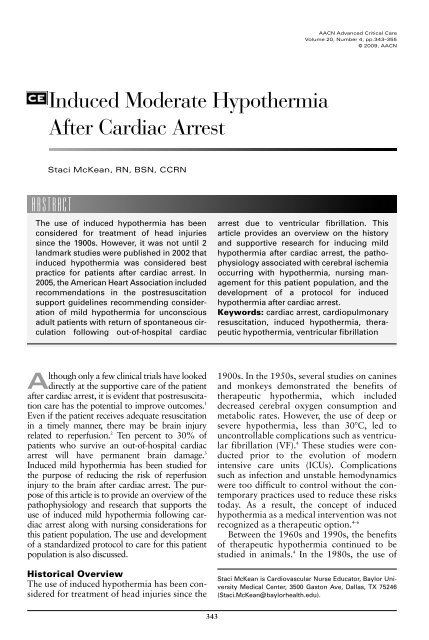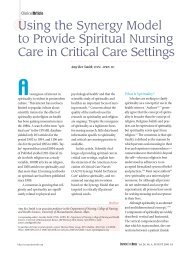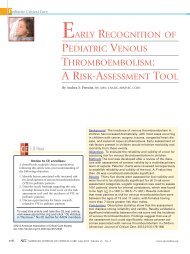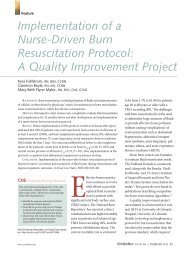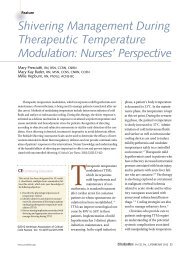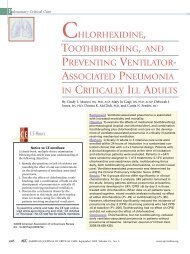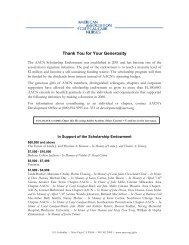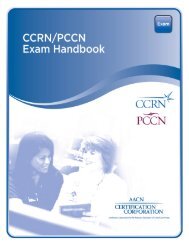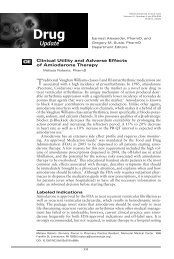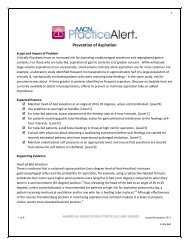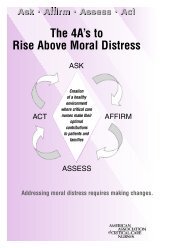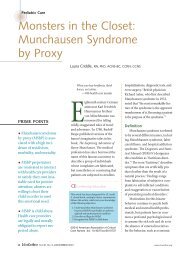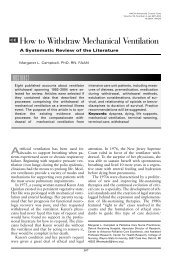Induced Moderate Hypothermia After Cardiac Arrest - American ...
Induced Moderate Hypothermia After Cardiac Arrest - American ...
Induced Moderate Hypothermia After Cardiac Arrest - American ...
Create successful ePaper yourself
Turn your PDF publications into a flip-book with our unique Google optimized e-Paper software.
AACN Advanced Critical Care<br />
Volume 20, Number 4, pp.343–355<br />
© 2009, AACN<br />
<strong>Induced</strong> <strong>Moderate</strong> <strong>Hypothermia</strong><br />
<strong>After</strong> <strong>Cardiac</strong> <strong>Arrest</strong><br />
Staci McKean, RN, BSN, CCRN<br />
ABSTRACT<br />
The use of induced hypothermia has been<br />
considered for treatment of head injuries<br />
since the 1900s. However, it was not until 2<br />
landmark studies were published in 2002 that<br />
induced hypothermia was considered best<br />
practice for patients after cardiac arrest. In<br />
2005, the <strong>American</strong> Heart Association included<br />
recommendations in the postresuscitation<br />
support guidelines recommending consideration<br />
of mild hypothermia for unconscious<br />
adult patients with return of spontaneous circulation<br />
following out-of-hospital cardiac<br />
arrest due to ventricular fibrillation. This<br />
article provides an overview on the history<br />
and supportive research for inducing mild<br />
hypothermia after cardiac arrest, the pathophysiology<br />
associated with cerebral ischemia<br />
occurring with hypothermia, nursing management<br />
for this patient population, and the<br />
development of a protocol for induced<br />
hypothermia after cardiac arrest.<br />
Keywords: cardiac arrest, cardiopulmonary<br />
resuscitation, induced hypothermia, therapeutic<br />
hypothermia, ventricular fibrillation<br />
Although only a few clinical trials have looked<br />
directly at the supportive care of the patient<br />
after cardiac arrest, it is evident that postresuscitation<br />
care has the potential to improve outcomes. 1<br />
Even if the patient receives adequate resuscitation<br />
in a timely manner, there may be brain injury<br />
related to reperfusion. 2 Ten percent to 30% of<br />
patients who survive an out-of-hospital cardiac<br />
arrest will have permanent brain damage. 3<br />
<strong>Induced</strong> mild hypothermia has been studied for<br />
the purpose of reducing the risk of reperfusion<br />
injury to the brain after cardiac arrest. The purpose<br />
of this article is to provide an overview of the<br />
pathophysiology and research that supports the<br />
use of induced mild hypothermia following cardiac<br />
arrest along with nursing considerations for<br />
this patient population. The use and development<br />
of a standardized protocol to care for this patient<br />
population is also discussed.<br />
Historical Overview<br />
The use of induced hypothermia has been considered<br />
for treatment of head injuries since the<br />
1900s. In the 1950s, several studies on canines<br />
and monkeys demonstrated the benefits of<br />
therapeutic hypothermia, which included<br />
decreased cerebral oxygen consumption and<br />
metabolic rates. However, the use of deep or<br />
severe hypothermia, less than 30C, led to<br />
uncontrollable complications such as ventricular<br />
fibrillation (VF). 4 These studies were conducted<br />
prior to the evolution of modern<br />
intensive care units (ICUs). Complications<br />
such as infection and unstable hemodynamics<br />
were too difficult to control without the contemporary<br />
practices used to reduce these risks<br />
today. As a result, the concept of induced<br />
hypothermia as a medical intervention was not<br />
recognized as a therapeutic option. 4–6<br />
Between the 1960s and 1990s, the benefits<br />
of therapeutic hypothermia continued to be<br />
studied in animals. 4 In the 1980s, the use of<br />
Staci McKean is Cardiovascular Nurse Educator, Baylor University<br />
Medical Center, 3500 Gaston Ave, Dallas, TX 75246<br />
(Staci.McKean@baylorhealth.edu).<br />
343
MCKEAN<br />
AACN Advanced Critical Care<br />
hypothermia on dogs after cardiac arrest<br />
demonstrated positive outcomes that included<br />
improved neurological status and survival outcomes.<br />
3 This led the medical community to<br />
explore induced hypothermia following cardiac<br />
arrest once again as a possible intervention<br />
for humans. 4 It was not until 2 landmark<br />
studies were published in 2002 that induced<br />
hypothermia was considered best practice for<br />
patients following cardiac arrest. 2<br />
Supportive Research<br />
Bernard and colleagues 7 compared the use of<br />
induced hypothermia with standard treatment<br />
for patients following VF arrest who remained<br />
comatose after return of spontaneous circulation<br />
(ROSC). Patients were randomly assigned<br />
to hypothermia or normothermia (standard<br />
care). The patients assigned to hypothermia<br />
were cooled to 33C within 2 hours after ROSC<br />
and were kept at that temperature for 12 hours.<br />
Of the 77 patients enrolled in the trial, 49%<br />
treated with hypothermia were discharged<br />
home or to a rehabilitation facility as compared<br />
with 26% of the patients treated with standard<br />
care. 7 The odds ratio for a good outcome with<br />
hypothermia compared with normothermia<br />
was 5.25 when baseline differences in age and<br />
time from collapse to ROSC were considered. 7<br />
The <strong>Hypothermia</strong> <strong>After</strong> <strong>Cardiac</strong> <strong>Arrest</strong><br />
Study Group 8 studied patients presenting in the<br />
emergency department with VF or nonperfusing<br />
ventricular tachycardia with ROSC. The<br />
patients randomly selected to receive hypothermia<br />
were cooled and maintained at 32C to<br />
34C for 24 hours. Fifty-five percent of patients<br />
who received hypothermia had a favorable<br />
outcome, indicating that the patient was able<br />
to live independently and work at least part<br />
time. Only 39% of patients who were maintained<br />
at normothermia had similar favorable<br />
outcomes. 8 Mortality at 6 months was 41% in<br />
the hypothermia group as compared with 55%<br />
in those who did not receive hypothermia. 8<br />
Several other studies have shown benefits<br />
related to induced mild hypothermia following<br />
cardiac arrest. Hachimi-Idrissi and colleagues 9<br />
conducted a study inducing hypothermia by<br />
using a helmet device containing a solution of<br />
aqueous glycerol around the head and neck to<br />
cool the patient to 34°C. Patients who had cardiac<br />
arrest from pulseless electrical activity or<br />
asystole of presumed cardiac origin were considered<br />
for this trial. Study results revealed<br />
patients who received hypothermia had a significantly<br />
higher central venous oxygen saturation<br />
and significantly lower arterial lactate<br />
concentrations and oxygen extraction ratio. 9<br />
Another study conducted by Oddo and colleagues<br />
10 included patients who experienced<br />
out-of-hospital cardiac arrest from VF, asystole,<br />
and pulseless electrical activity. A good<br />
outcome, defined as Glasgow–Pittsburgh<br />
Cerebral Performance Category 1 or 2, was<br />
seen in 55.8% of the patients who received<br />
hypothermia treatment as compared with<br />
25.6% treated with standard treatment for<br />
patients with cardiac arrest due to VF. 10<br />
In October 2002, the International Liaison<br />
Committee on Resuscitation (ILCOR) made the<br />
recommendation, based on the above evidence,<br />
that all unconscious adult patients with ROSC<br />
following out-of-hospital cardiac arrest due to<br />
VF should be cooled to 32°C to 34°C for 12 to<br />
24 hours. ILCOR also stated that other<br />
rhythms that cause cardiac arrest and in-hospital<br />
cardiac arrests may benefit from hypothermia.<br />
11 In 2005, the <strong>American</strong> Heart Association<br />
(AHA) included these recommendations in the<br />
postresuscitation support guidelines. 1<br />
Effects of Cerebral Ischemia and<br />
<strong>Induced</strong> <strong>Hypothermia</strong><br />
The brain has a small amount of oxygen<br />
stores. When cerebral perfusion and oxygen<br />
delivery stop during cardiac arrest, the oxygen<br />
stores are depleted within 20 seconds. 6 If a<br />
patient was connected to continuous electroencephalography<br />
(EEG) during cardiac<br />
arrest, clinicians would see isoelectric lines<br />
after 20 seconds, indicating no brain activity<br />
present. 4 <strong>After</strong> oxygen is depleted, the brain<br />
turns to anaerobic metabolism to sustain function.<br />
Glucose and adenosine triphosphate levels<br />
are depleted after 5 minutes if return of<br />
blood flow is not achieved. 6 This causes ion<br />
pumps that use adenosine triphosphate to fail,<br />
allowing for electrolyte imbalance, including<br />
potassium, sodium, and calcium, resulting in<br />
cellular edema and cell death. 12<br />
<strong>After</strong> ROSC, it would be assumed that once<br />
oxygen supply was returned to the brain, cell<br />
death would stop. However, it is believed that<br />
reperfusion initiates chemical processes that<br />
lead to inflammation and continued injury in<br />
the brain. This is known as reperfusion injury.<br />
Reperfusion injury is thought to include the<br />
release of free radicals, nitric oxide, catecholamines,<br />
cytokines, and calcium shifts,<br />
which all lead to mitochondrial damage and<br />
344
VOLUME 20 • NUMBER 4 • OCTOBER–DECEMBER 2009<br />
INDUCED MODERATE HYPOTHERMIA AFTER CARDIAC ARREST<br />
cell death. This process may last as long as 24<br />
to 48 hours. 2,6,12,13 In low perfusion states, the<br />
blood–brain barrier is disrupted, leading to<br />
worsening cerebral edema. 13<br />
The complete benefits of induced hypothermia<br />
are not well understood. The cerebral metabolic<br />
rate is decreased by 6% to 7% for every<br />
1°C decrease in the body temperature. 5 Decreasing<br />
the cerebral metabolic rate decreases cerebral<br />
oxygen consumption. 2 <strong>Hypothermia</strong> helps<br />
to stabilize the influx of calcium and glutamate<br />
by slowing the neuroexcitatory processes,<br />
thereby reducing the disruptions in the<br />
blood–brain barrier and preventing premature<br />
cell death. 13 <strong>Hypothermia</strong> is also thought to<br />
decrease many of the chemical reactions that<br />
occur during reperfusion, such as free radical<br />
production. 2 Temperatures less than 35°C lead<br />
to decreased neutrophil and macrophage functions.<br />
This reduces the inflammatory response<br />
that is initiated after ischemia. 13<br />
<strong>Hypothermia</strong> Methods<br />
Several methods may be used to induce and<br />
maintain hypothermia. The methods may be<br />
classified as noninvasive and invasive.<br />
Noninvasive <strong>Induced</strong> <strong>Hypothermia</strong><br />
Noninvasive methods include traditional<br />
interventions such as using ice packs, fans,<br />
alcohol baths, and cooling blankets not<br />
attached to automatic temperature control<br />
modules. These methods are extremely labor<br />
intensive and require manual control of the<br />
patient’s temperature. The nurse must closely<br />
monitor the patient’s temperature and regulate<br />
the intervention to achieve and maintain the<br />
target temperature. In some instances this may<br />
require staffing to be 1:1. Also, the literature<br />
does not provide strong evidence for best<br />
practice using these methods. No specific<br />
guidelines are available for the noninvasive<br />
induction of hypothermia, such as “place 4 bags<br />
of ice to the axillary and groin areas and when<br />
the patient’s temperature reaches 34.5C<br />
remove one bag.” These methods are based<br />
more on the nurse’s judgment, without any<br />
specific evidence for achieving best outcomes.<br />
A much higher risk of unintentional overcooling<br />
or warming too quickly with these traditional<br />
methods has been shown. Rewarming is<br />
a definite problem with these techniques. It<br />
has also been shown that noninvasive methods<br />
may take a prolonged time to reach the target<br />
temperature or it may not be achieved at all.<br />
However, these methods are more readily<br />
available at most institutions. The equipment<br />
cost may also be lower although the cost for<br />
the 1:1 nurse–patient ratio may be more. 13,14<br />
Improvements and advances have been<br />
observed in some of the noninvasive methods<br />
that help decrease labor intensity and risks<br />
involved with induced hypothermia. The Arctic<br />
Sun by Medivance (Louisville, CO) (Figure 1)<br />
uses gel pads placed on the patient’s skin to<br />
cover approximately 40% of the patient’s<br />
body. The pads may even be pulled back and<br />
reapplied as many times as needed, allowing<br />
access for patient care. Water circulates<br />
through the pads using a negative pressure system,<br />
which minimizes the risks of leaks as<br />
compared with other devices. The pads and a<br />
patient temperature source, such as a temperature-sensing<br />
urinary catheter, are connected to<br />
a console that automatically adjusts water<br />
temperature to achieve and maintain target<br />
temperature. It also provides a way for controlled<br />
warming to help prevent rebound<br />
hyperthermia. 13,15<br />
Invasive <strong>Induced</strong> <strong>Hypothermia</strong><br />
Invasive methods include use of iced (4°C)<br />
intravenous fluids and the use of intravascular<br />
catheters. A few studies show that use of iced<br />
intravenous fluids may be effective in inducing<br />
hypothermia. 16,17 In a study by Bernard and<br />
colleagues, 16 lactated Ringer solution was<br />
stored in the emergency department blood<br />
refrigerator with a controlled temperature of<br />
4°C until needed. When a patient was identified<br />
for the study, 30 mL/kg of the lactated<br />
Ringer solution was infused over 30 minutes<br />
by using a pressure bag. Ice packs were then<br />
placed to maintain temperature at 33C for<br />
12 hours. 16 Kliegel and colleagues 17 infused<br />
2000 mL of iced lactated Ringer solution<br />
when patients met criteria for their study. As<br />
soon as possible, an intravascular catheter was<br />
placed and connected to a cooling device to<br />
maintain the temperature at 33C for 24<br />
hours. 17 Iced intravenous fluids may help to<br />
induce hypothermia quickly in the emergency<br />
department and has the potential for being<br />
started out in the field by paramedics.<br />
Machines such as the CoolGard 3000 or<br />
the newer version Thermogard XP (Figure 2)<br />
by Alsius (Irvine, CA) use an automatic temperature-control<br />
module similar to that used<br />
by the Arctic Sun. These devices by Alsius use<br />
a closed-loop central venous catheter usually<br />
345
MCKEAN<br />
AACN Advanced Critical Care<br />
Figure 1: Arctic Sun noninvasive automatic temperature control device. Used with permission from<br />
Medivance Corporation.<br />
inserted into the femoral vein. Once the<br />
catheter is connected to the control module,<br />
cold water circulates through the balloons on<br />
the tip of the catheter. The blood is cooled as it<br />
passes by the balloons. Invasive methods such<br />
as the CoolGard 3000 require the placement of a<br />
catheter by a physician credentialed in placing<br />
central venous catheters. This carries the risk of<br />
any central venous catheter, including bleeding,<br />
infection, deep vein thrombosis, vascular puncture,<br />
and pneumothorax, if placed in the chest.<br />
However, patients requiring induced hypothermia<br />
usually will also need a central venous<br />
catheter for other interventions such as medication<br />
administration and frequent blood draws.<br />
The central venous catheter, such as the catheters<br />
that accompany the CoolGard 3000, have 3 ports<br />
that may be used as infusion ports while cooling<br />
or warming the patient. It may continue to be<br />
used as a central venous catheter once the<br />
hypothermia procedure is completed. 13,18<br />
Extensive research has not been conducted<br />
that examines which method produces the best<br />
outcome for the patient. Hoedemaekers and<br />
colleagues 19 compared the use of iced intravenous<br />
fluids followed by ice packs (conventional<br />
cooling); an air-circulating cooling<br />
system that used 1 blanket over the patient; a<br />
346
VOLUME 20 • NUMBER 4 • OCTOBER–DECEMBER 2009<br />
INDUCED MODERATE HYPOTHERMIA AFTER CARDIAC ARREST<br />
Figure 2: Thermogard XP invasive automatic temperature control device. Used with permission from<br />
Alsius Corporation.<br />
water-circulating cooling system that used<br />
blankets placed under and over the patient and<br />
behind the patient’s head; a gel-coated external<br />
cooling device; and an intravascular cooling<br />
system. The last 3 methods were connected<br />
to automatic temperature control modules.<br />
This study found that the methods that used<br />
an automatic temperature control had a significantly<br />
higher speed of cooling. 19 All 3 automatic<br />
temperature control methods were<br />
equally effective in inducing the target temperature.<br />
The intravascular method was significantly<br />
more reliable in maintaining the target<br />
temperature as compared with all other<br />
groups. The target temperature was out of<br />
range 3.2% (4.8%) with the intravascular<br />
catheter compared with 69.8% (37.6%)<br />
with conventional cooling, 50% (35.9%)<br />
with the water-circulating cooling device,<br />
74.1% (40.5%) with the air-circulating<br />
cooling device, and 44.2% (33.7%) with the<br />
gel-coated external cooling system. 19 The<br />
intravascular method group also had no<br />
patients overshoot the target temperature.<br />
One patient who was cooled with conventional<br />
cooling, 3 who were cooled with the<br />
water-circulating device, and 3 who were<br />
cooled with the gel-coated external cooling<br />
device overshot the target temperature by<br />
more than 0.5C. 19 In this study, no adverse<br />
events were noted related to any specific cooling<br />
method. 19<br />
Patient Management and<br />
Nursing Care<br />
As previously discussed, induced moderate<br />
hypothermia following cardiac arrest has been<br />
shown to improve patient outcomes. It, however,<br />
347
MCKEAN<br />
AACN Advanced Critical Care<br />
is beneficial only if the health care team knows<br />
how to care for this patient population. Nursing<br />
care and support is crucial. Patient management<br />
and the vital nursing care needed for this<br />
patient population are described below.<br />
Table 1: The Bedside Shivering<br />
Assessment Scale a<br />
Score<br />
Definition<br />
0 None: no shivering noted on palpation of<br />
the masseter, neck, or chest wall<br />
1 Mild: shivering localized to the neck<br />
and/or thorax only<br />
2 <strong>Moderate</strong>: shivering involves gross<br />
movement of the upper extremities (in<br />
addition to neck and thorax)<br />
3 Severe: shivering involves gross<br />
movements of the trunk and upper and<br />
lower extremities<br />
a Used with permission from Badjatia et al, “Metabolic Impact of<br />
Shivering During Therapeutic Temperature Modulation: The Bedside<br />
Shivering Assessment Scale,” Stroke, 2008, vol. 39, pp. 3242--3247. 21<br />
Prevention of Shivering<br />
Shivering is a natural body response to<br />
hypothermia. If this natural response is allowed<br />
to occur while inducing hypothermia, there<br />
may be difficulty in achieving the target temperature.<br />
Shivering increases metabolic rate and<br />
oxygen consumption. Most protocols use a<br />
combination of sedation and paralytic agents to<br />
prevent shivering especially during induction. 20<br />
Shivering is less likely to occur during the maintenance<br />
and warming phases. The paralytic<br />
may be stopped during the warming phase. 13,20<br />
Patients should be monitored for signs and<br />
symptoms of shivering, including a drop in<br />
mixed venous oxygen saturation, increase in<br />
respiratory rate, facial tensing, static tracing<br />
on the electrocardiogram, and palpation of<br />
muscle fasciculations on the face or chest. 13<br />
The Bedside Shivering Assessment Scale (Table 1)<br />
may be used by nurses to provide a universal<br />
assessment tool for shivering. 21 The nurse must<br />
ensure that analgesia and sedation are optimized<br />
and that the patient is intubated with<br />
the ventilator set to proper parameters to provide<br />
adequate ventilation prior to the start of<br />
the paralytic treatment. A train of 4 should be<br />
established prior to initiation of continuous<br />
paralytics and continued to be monitored for a<br />
goal of 1 out 4. 13,20 It may be difficult to obtain<br />
train of 4 assessments due to peripheral vasoconstriction<br />
during hypothermia. 13 The nurse<br />
might need to rely on clinical indicators such<br />
as overbreathing on the ventilator and spontaneous<br />
movement to know if the paralytic<br />
agent is optimized.<br />
Sedation and analgesic drugs, such as midazolam,<br />
fentanyl, and propofol, have a 30% to<br />
50% decrease in systemic clearance during<br />
hypothermia. For neuromuscular-blocking<br />
agents, such as vecuronium and atracurium,<br />
clearance is decreased 10% for every 1C<br />
below 37C. Their duration of action is also<br />
increased. 20 The least amount of drug should<br />
be used to provide the needed effect. During<br />
hypothermia, the amount of drug required<br />
may be less than what is typically used. 13 The<br />
health care team must be mindful that the<br />
patient may take longer to wake up after treatment.<br />
20 The paralytic and sedation medications<br />
should be stopped as soon as possible<br />
after the completion of induced hypothermia<br />
treatment.<br />
Vital Sign Monitoring<br />
A patient’s normal response to hypothermia is<br />
to increase the heart rate and vasoconstrict in<br />
an attempt to conserve heat. The use of sedation<br />
and paralytic agents prevents this normal<br />
response to hypothermia. Bradycardia and<br />
increased systemic vascular resistance will be<br />
seen in the absence of shivering and with a continued<br />
decrease in temperature. The bradycardia<br />
is usually not hemodynamically significant<br />
and usually refractory to atropine. It is not<br />
always necessary to terminate treatment for<br />
patients who are bradycardic. Blood pressure is<br />
usually maintained without the use of vasopressors<br />
secondary to the increased systemic vascular<br />
resistance. Vasopressors may be used to<br />
maintain systolic blood pressure greater than<br />
90 mm Hg or mean arterial pressure greater<br />
than 60 mm Hg. The patient may be pale, and<br />
peripheral pulses may be difficult to obtain<br />
because of the vasoconstriction. The greatest<br />
risk for hypotension is during the warming<br />
phase secondary to vasodilation. It is critical at<br />
the start of warming that vital signs are monitored<br />
closely. 2,5,20 Ideally, an arterial catheter will<br />
be inserted for continuous blood pressure measurement.<br />
However, if one is not available, then<br />
noninvasive measurements should be obtained<br />
at least every 30 minutes and more often during<br />
induction of warming. 6,20<br />
Continuous electrocardiogram monitoring<br />
is imperative. Dysrhythmias are rare in mild<br />
348
VOLUME 20 • NUMBER 4 • OCTOBER–DECEMBER 2009<br />
INDUCED MODERATE HYPOTHERMIA AFTER CARDIAC ARREST<br />
hypothermia. The patient is more at risk when<br />
the temperature drops below 32C. Temperatures<br />
below 30C may cause VF and may be<br />
refractory to defibrillation. 6 Prolonged QT<br />
intervals may be noted during cooling and for<br />
several days to weeks after treatment. 5 The<br />
physician should be notified of any change in<br />
rhythm and hemodynamic instability. The<br />
patient must be kept well hydrated during<br />
cooling to help prevent hypotension during<br />
warming when vasodilation occurs. 2,5,6,20<br />
Skin Care<br />
Peripheral vasoconstriction places the patient<br />
at a particularly high risk for skin breakdown.<br />
Extra attention to skin assessment, skin care,<br />
and frequent turning is necessary. The risk<br />
may be slightly increased with the use of surface-cooling<br />
methods such as cooling blankets.<br />
The nurse should be cautious when placing<br />
noninvasive surface cooling devices on fragile<br />
skin and should avoid open skin areas or<br />
wounds. 6,13,15<br />
Fluid and Laboratory Value Monitoring<br />
Fluid and electrolyte imbalances may occur<br />
during hypothermia and during the warming<br />
phase. Cold diuresis occurs during hypothermia<br />
because there is a decrease in the reabsorption<br />
of solute in the ascending limb of the<br />
loop of Henle. Suppression of the antidiuretic<br />
hormone also exists. Fluid status should be<br />
monitored and maintained. 5<br />
Electrolyte shifts may occur from cold diuresis<br />
and from cellular acidosis that may occur during<br />
hypothermia. Electrolytes such as potassium,<br />
magnesium, phosphorus, and calcium should be<br />
monitored and replaced. <strong>Hypothermia</strong> causes<br />
potassium to shift into the cells and hypokalemia<br />
may occur. 6,13 Risk for hyperkalemia during<br />
warming exists because the potassium shifts<br />
back, out of the cells. 6,13<br />
Potassium replacement should be given<br />
during cooling, to prevent dysrhythmias.<br />
Replacement should be conservative and<br />
possibly discontinued several hours before<br />
warming begins. The patient is at particular<br />
risk for hyperkalemia if the hypokalemia was<br />
overtreated during the cooling phase. The<br />
patient may still require replacement during<br />
the warming phase if the potassium level is<br />
significantly low. 6,13<br />
Hemoconcentration may be noticed during<br />
hypothermia because of the cold diuresis and<br />
fluid shifts from the intravascular space related<br />
to changes in vascular permeability. 5 For every<br />
1C decline in temperature, the hematocrit<br />
increases by approximately 2%. 5<br />
Coagulopathy may occur during hypothermia.<br />
Platelet counts decrease, and there is an<br />
inhibition of enzyme reactions of both the<br />
intrinsic and extrinsic pathways of the clotting<br />
cascade. 5 Laboratory test values, such as partial<br />
thromboplastin time, prothrombin time,<br />
and international normalized ratio, should be<br />
monitored. Platelets or fresh frozen plasma<br />
should be given only if a clinical concern is<br />
present and not based on the laboratory test<br />
values alone. Studies have shown that there is<br />
not a significant risk of bleeding during<br />
hypothermia. 13,20<br />
Prevention of Infection<br />
Patients receiving induced hypothermia following<br />
cardiac arrest are at high risk for infection<br />
and sepsis. <strong>Hypothermia</strong> decreases the<br />
number of circulating white blood cells. It also<br />
causes a decreased release of insulin from the<br />
pancreas and causes insulin resistance at the<br />
cellular level. Patients may exhibit refractory<br />
hyperglycemia. Hyperglycemia should be controlled<br />
using insulin treatment with frequent<br />
monitoring, and some patients may even<br />
require a continuous insulin intravenous infusion.<br />
Glucose should be controlled at levels<br />
less than 150 mg/dL. Strict glucose control,<br />
less than 110 mg/dL, has not been shown to<br />
improve outcomes and carries a higher risk of<br />
hypoglycemia. 20 Intravenous fluids that contain<br />
glucose should be avoided. 20<br />
Patients are also at high risk for aspiration<br />
and ventilator-associated pneumonia because<br />
hypothermia causes impairment of ciliary<br />
function reducing airway protective mechanisms.<br />
These patients also tend to require prolonged<br />
ventilation. Wound infections may<br />
have delayed healing as hypothermia decreases<br />
subcutaneous oxygen tension. 5,6,13<br />
Skin care, frequent turning, use of sterile<br />
technique when manipulating catheters, and<br />
use of ventilator bundles will help decrease the<br />
risk of infection. 6 Elevated temperatures related<br />
to infection will be masked by hypothermia, so<br />
other indicators of infection need to be monitored<br />
and considered. Prevention is the key. 13<br />
Rewarming<br />
Guidelines have not been established for how<br />
fast a patient should be warmed. Most recommend<br />
warming the patient at 0.5C to 1C per<br />
349
MCKEAN<br />
AACN Advanced Critical Care<br />
hour. Warming must be done slowly to prevent<br />
complications, such as rebound hyperthermia,<br />
which increases cerebral edema. Other complications<br />
that may occur during warming include<br />
seizures, VF, and hypotension. Fever is common<br />
in the first 48 hours after the completion<br />
of hypothermia treatment. This may be neurologically<br />
mediated, inflammation, or infection<br />
related. The risk of poor neurological outcome<br />
is increased for each degree over 37C reached<br />
in the post–cardiac arrest patient. 5,6,13,20,22<br />
Hyperoxia should be avoided in this patient<br />
population. Research has shown ventilation<br />
with 100% oxygen in the first hour after<br />
experimental cardiac arrest resulted in worse<br />
neurological outcomes. 20 Excessive oxygen<br />
harms postischemic neurons by causing excessive<br />
oxidative stress in the early stages of<br />
reperfusion. 20 Monitor and titrate oxygen<br />
levels by using arterial blood gases and by continuous<br />
saturation monitoring. 20<br />
Quality of care is directly related to outcomes<br />
for this patient population. It is vital that<br />
standard ICU care, such as frequent turning,<br />
oral care, use of ventilator bundles, head of bed<br />
at 30º, strict input and output, sterile technique<br />
when manipulating catheters, glucose level control,<br />
peptic ulcer, and deep vein thrombosis prophylaxis,<br />
be provided for all ICU patients but<br />
especially for this patient population. 6<br />
Protocol Development<br />
The development of a standardized protocol or<br />
order set should be considered before using<br />
induced mild hypothermia following cardiac<br />
arrest. One study indicated that temperature<br />
goals for induced hypothermia could be reliably<br />
achieved when a standardized order set was<br />
used. 23 A protocol should identify the patient<br />
population that is appropriate to receive the<br />
treatment and direct care and assessments. Recommendations<br />
from the AHA and published<br />
research can be utilized to facilitate development<br />
of the protocol. Using examples of order<br />
sets from other institutions may be helpful. If a<br />
particular device is going to be used for cooling,<br />
the company’s experts may also assist in the<br />
development of the order set. The remainder of<br />
this article discusses what should be considered<br />
when developing a protocol for induced<br />
hypothermia following cardiac arrest.<br />
The induced therapeutic mild hypothermia<br />
post–cardiac arrest order set from Baylor University<br />
Medical Center (BUMC) in Dallas,<br />
Texas, is used as an example during this discussion<br />
(Figure 3). A standardized protocol for<br />
inducing mild hypothermia following cardiac<br />
arrest was initiated in 2005. As more research<br />
became available and lessons were learned<br />
during use of the protocol, revisions were<br />
made to reflect the new AHA recommendations<br />
and research. The protocol was also<br />
revised to provide clarity to the health care<br />
team in caring for these patients and answer<br />
questions that were raised with the use of the<br />
initial protocol.<br />
Inclusion and exclusion criteria were developed<br />
based on the 2 studies published by<br />
Bernard 7 and the <strong>Hypothermia</strong> <strong>After</strong> <strong>Cardiac</strong><br />
<strong>Arrest</strong> Study Group, 8 the AHA recommendations,<br />
1 ILCOR recommendations, 11 and lessons<br />
learned during use of the initial protocol. The<br />
inclusion and exclusion criteria are detailed in<br />
the protocol to assist the health care team to<br />
identify appropriate patients.<br />
Identification of Appropriate<br />
Patients for <strong>Induced</strong> <strong>Hypothermia</strong><br />
At BUMC, all unconscious, post–cardiac arrest<br />
patients with ROSC whose arrest was believed<br />
to be of cardiac origin are considered for<br />
induced hypothermia. It is an AHA class IIa<br />
recommendation that all unconscious patients<br />
with ROSC after out-of-hospital VF cardiac<br />
arrests receive induced hypothermia. 1 The<br />
AHA also recommends that induced hypothermia<br />
may be beneficial in non-VF arrests for<br />
out-of-hospital or in-hospital arrests. 1 Bernard<br />
et al 7 and the <strong>Hypothermia</strong> <strong>After</strong> <strong>Cardiac</strong><br />
<strong>Arrest</strong> Study Group 8 excluded patients who<br />
experienced cardiac arrests of noncardiac etiology,<br />
such as respiratory failure, from their clinical<br />
trials. 7,8,11 Therefore, cardiac arrests of<br />
noncardiac etiology are excluded at BUMC<br />
until future studies are completed.<br />
Following the <strong>Hypothermia</strong> <strong>After</strong> <strong>Cardiac</strong><br />
<strong>Arrest</strong> Study Group 8 study design, only those<br />
patients with cardiac arrests that are witnessed<br />
with less than 15 minutes to the first attempt<br />
of resuscitation and ROSC in less than 60 minutes<br />
are considered for this protocol. 8 Patients<br />
who are unable to maintain a systolic blood<br />
pressure of 90 mm Hg despite intravenous<br />
fluids or vasopressors are also not considered<br />
as candidates. 7,8<br />
One of the inclusion criteria on the initial<br />
protocol was coma without a definition. It was<br />
found that the health care team had different<br />
definitions of coma. For this protocol, coma was<br />
defined as “coma suggested by the following:<br />
350
VOLUME 20 • NUMBER 4 • OCTOBER–DECEMBER 2009<br />
INDUCED MODERATE HYPOTHERMIA AFTER CARDIAC ARREST<br />
Figure 3: Sample order set for induced therapeutic mild hypothermia following cardiac arrest. Used with<br />
permission from Baylor University Medical Center, Dallas, Texas.<br />
unable to follow commands; does not open eyes<br />
to painful stimulus; and Glasgow Coma Scale<br />
score less than or equal to 8.”<br />
Patients with life-threatening arrhythmias<br />
or primary coagulopathy or those who are<br />
pregnant should not receive induced hypothermia<br />
because of the lack of available research. 11<br />
The BUMC protocol excludes patients with a<br />
temperature of 30C or below after ROSC<br />
because the patient is already below the target<br />
temperature of 33C. A further drop in temperature<br />
could lead to life-threatening arrhythmias.<br />
Also, patients with known sepsis are<br />
excluded because of the increased risk of infection<br />
during hypothermia. The team decided to<br />
also exclude patients with a known history of<br />
351
MCKEAN<br />
AACN Advanced Critical Care<br />
terminal illness prior to arrest. Patients who<br />
require thrombolytic therapy are not to be<br />
excluded from treatment. 11<br />
BUMC-<strong>Induced</strong><br />
<strong>Hypothermia</strong> Protocol<br />
The AHA recommends cooling these patients<br />
to 32C to 34C for 12 to 24 hours. 1 This facility<br />
uses devices that automatically control the<br />
temperature. The target temperature for<br />
hypothermia is set at 33C and is maintained at<br />
33C for 18 hours once the target temperature<br />
is achieved. If it takes 4 to 5 hours to reach the<br />
target temperature, then the cooling process<br />
will take approximately 23 to 24 hours as recommended<br />
by the AHA. 1 The patient is then<br />
warmed at 0.5C per hour. The target temperature<br />
for warming is set to 36.5C to avoid poor<br />
neurological outcomes associated with temperatures<br />
above 37C. 20<br />
The goal is to begin induction of hypothermia<br />
and achieve target temperature as soon as<br />
possible after ROSC. However, hypothermia<br />
may still be beneficial if induction is delayed<br />
for 4 to 6 hours after ROSC. 5 The physician<br />
should be notified if the target temperature is<br />
not achieved within a reasonable time.<br />
Bernard and colleagues’ goal of achieving the<br />
target temperature was 2 hours. 7 The median<br />
time to target temperature in the study conducted<br />
by Oddo and colleagues 10 was 5 hours. 10<br />
BUMC decided to consider patients for the<br />
hypothermia protocol when it had been less<br />
than 6 hours since the ROSC, with 4 hours as<br />
the goal to achieve the target temperature once<br />
cooling is started.<br />
Shivering should be considered as a possible<br />
reason for not achieving target temperature<br />
within a reasonable time frame. Sedation and/or<br />
paralytic agents should be considered to help<br />
prevent shivering. The nurse should verify that<br />
both are optimized. 13 If the patient is receiving<br />
dialysis, it should be verified that the blood<br />
warmer is switched off. 20 The physician may<br />
also consider infusing iced sodium chloride to<br />
achieve target temperature more rapidly. 16,17<br />
The patient’s temperature should be monitored<br />
continuously during the entire treatment.<br />
Most automatic temperature control modules<br />
require continuous temperature monitoring of<br />
the patient in adjusting the water temperature<br />
to maintain the target temperature. Studies<br />
have not indicated the best method for monitoring<br />
temperatures continuously. Bladder temperature<br />
is the primary method used at BUMC,<br />
because the patients already require a urinary<br />
catheter for strict input and output monitoring.<br />
The equipment was also already available in the<br />
hospital. However, studies have indicated that<br />
bladder temperatures may be inaccurate when<br />
there is decreased urine output. 24 The nursing<br />
staff members have also found that obtaining<br />
temperature readings with the temperaturesensing<br />
urinary catheter is difficult when the<br />
patient is anuric or has decreased urine output.<br />
As a result, the team decided that rectal temperature<br />
monitoring would be used for these<br />
patients.<br />
The literature indicates different intervals for<br />
how often to monitor vital signs including<br />
blood pressure if an arterial catheter is not present.<br />
We decided to check vital signs every 30<br />
minutes, which is within the recommendations<br />
found in the literature. 5,6 Vital signs assessment<br />
is then performed every 15 minutes for 2 hours<br />
during the warming phase due to the increased<br />
risk of hypotension related to vasodilation.<br />
Recommendations for laboratory tests such<br />
as basic metabolic panel, complete blood cell<br />
count, magnesium, ionic calcium, partial thromboplastin<br />
time, prothrombin time, and international<br />
normalized ratio exist for patients<br />
receiving induced hypothermia. 6 A recommendation<br />
for frequency of serial laboratory studies<br />
could not be found. Laboratory test results<br />
should be obtained to determine baseline values<br />
prior to induction of hypothermia. We choose to<br />
perform the laboratory tests listed above at<br />
induction and then every 6 hours through the<br />
course of treatment. This is to allow time for<br />
treatment between laboratory draws if needed.<br />
Once the patient is normothermic, laboratory<br />
assessments are changed to daily for 48 hours.<br />
Potassium replacement should be considered<br />
in the protocol. Potassium is held for 4<br />
hours prior to the start of warming because of<br />
the risk of hyperkalemia as potassium shifts<br />
out of the cell. 6 The physician is contacted during<br />
this time if the potassium is less than<br />
3.4 mEq/L or if arrhythmias are noted. The<br />
potassium replacement protocol is restarted<br />
once the patient is normothermic.<br />
The sedation, analgesic, and paralytic protocols<br />
already used in the ICUs were incorporated<br />
into this protocol. These were used to decrease<br />
confusion and reduce the risk of medication<br />
administration errors because there is familiarity<br />
with these protocols. Questions occurred<br />
with use of the initial protocol regarding when<br />
to stop the paralytic and sedation treatments.<br />
352
VOLUME 20 • NUMBER 4 • OCTOBER–DECEMBER 2009<br />
INDUCED MODERATE HYPOTHERMIA AFTER CARDIAC ARREST<br />
Some of the literature suggests discontinuing<br />
the paralytic treatment at the beginning of the<br />
warming phase although no exact guidelines<br />
were found. 13,20 Our protocol requires the paralytic<br />
treatment to be turned off 4 hours after the<br />
warming phase is started. This allows the nurse<br />
to concentrate on the patient’s hemodynamic<br />
status at the beginning of the warming phase,<br />
before changing other parameters.<br />
Because patients receiving induced<br />
hypothermia are at risk for refractory hyperglycemia,<br />
glucose level should be monitored<br />
and treated with sliding-scale insulin. Consider<br />
adding the ability to start an insulin infusion if<br />
a protocol already exists and the blood glucose<br />
level is higher than 150 mg/dL more than 2<br />
times during the hypothermia treatment.<br />
Use of facility-based standardized protocols<br />
that are applicable to induced hypothermia<br />
following cardiac arrest is beneficial. This contributes<br />
to making the process of induced<br />
hypothermia similar to the care of other ICU<br />
patients. Providing a protocol that follows<br />
other current practices and gives detailed<br />
instructions may provide consistent implementation<br />
of induced hypothermia postarrest and<br />
prevent complications from the treatment.<br />
Conclusion<br />
<strong>Induced</strong> mild hypothermia following cardiac<br />
arrest has been slow to be implemented across<br />
the medical community even with the AHA<br />
recommendations and research that shows the<br />
benefits. 23 The methods for inducing and<br />
maintaining hypothermia are improving, making<br />
it a more feasible treatment option for any<br />
hospital. The development and use of a standardized<br />
protocol can facilitate standardization<br />
of care for this patient population.<br />
Acknowledgment<br />
The author thanks Barbara “Bobbi” Leeper,<br />
MN, RN, CNS, CCRN, FAHA, for being a<br />
wonderful mentor and for her assistance in the<br />
preparation and review of this manuscript.<br />
References<br />
1. <strong>American</strong> Heart Association. 2005 <strong>American</strong> Heart Association<br />
Guidelines for Cardiopulmonary Resuscitation<br />
and Emergency Cardiovascular Care, 7.5: postresuscitation<br />
support. Circulation. 2005;112(24)(suppl):IV-84–IV-88.<br />
2. Calver P, Braungardt T, Kupchik N, Jensen A, Cutler C.<br />
The big chill: improving the odds after cardiac arrest.<br />
RN. 2005;68(5):58–62.<br />
3. Safer J, Kochanek P. Therapeutic hypothermia after<br />
cardiac arrest [editorial]. N Engl J Med. 2002;346:<br />
612–613.<br />
4. Varon J, Pilar A. Therapeutic hypothermia: past, present,<br />
and future. Chest. 2008;133(5):1267–1274.<br />
5. Keresztes P, Brick K. Therapeutic hypothermia after cardiac<br />
arrest. Dimens Crit Care Nurs. 2006;25(2):71–76.<br />
6. Cushman L, Warren M, Livesay S. Bringing research to<br />
the bedside: the role of induced hypothermia in cardiac<br />
arrest. Crit Care Nurs Q. 2007;30(2):143–153.<br />
7. Bernard S, Gray T, Buist M, et al. Treatment of comatose<br />
survivors of out-of-hospital cardiac arrest with induced<br />
hypothermia. N Engl J Med. 2002;346:557–563.<br />
8. <strong>Hypothermia</strong> after <strong>Cardiac</strong> <strong>Arrest</strong> Study Group. Mild therapeutic<br />
hypothermia to improve the neurologic outcome<br />
after cardiac arrest. N Engl J Med. 2002;346:549–556.<br />
9. Hachimi-Idrissi S, Corne L, Ebinger G, Michotte Y,<br />
Huyghens L. Mild hypothermia induced by a helmet<br />
device: a clinical feasibility study. Resuscitation. 2001;51:<br />
275–281.<br />
10. Oddo M, Schaller MD, Feihl F, Ribordy V, Liaudet L. From<br />
evidence to clinical practice: effective implementation of<br />
therapeutic hypothermia to improve patient outcome<br />
after cardiac arrest. Crit Care Med. 2006;34(7):1865–1873.<br />
11. Nolan J, Morley P, Vanden Hoek R, et al. Therapeutic<br />
hypothermia after cardiac arrest: an advisory statement<br />
by the advanced life support task force of the International<br />
Liaison Committee of Resuscitation. Circulation.<br />
2003;108:118–121.<br />
12. Bader MK, Rovzar M, Baumgartner L, Winokur R, Cline<br />
J, Schiffman G. Keeping cool: a case for hypothermia<br />
after cardiopulmonary resuscitation. Am J Crit Care.<br />
2007;16(6):631–635.<br />
13. Holden M, Makic M. Clinically induced hypothermia: why<br />
chill your patient. Adv Crit Care. 2006;17(2):125–132.<br />
14. Merchant R, Abella B, Peberdy M, et al. Therapeutic<br />
hypothermia after cardiac arrest: unintentional overcooling<br />
is common using ice packs and conventional cooling<br />
blankets. Crit Care Med. 2006;34(12)(suppl):S490–S494.<br />
15. Medivance Web site. Arctic Sun ® temperature management<br />
system. http://www.medivance.com/html/products<br />
_arcticgel.htm. Accessed December 31, 2008.<br />
16. Bernard S, Buist M, Monteir O, Smith K. <strong>Induced</strong><br />
hypothermia using large volume, ice-cold intravenous<br />
fluid in comatose survivors of out-of-hospital cardiac<br />
arrest: a preliminary report. Resuscitation. 2003;56:9–13.<br />
17. Kliegel A, Losert H, Sterz F, et al. Cold simple intravenous<br />
infusions preceding special endovascular cooling<br />
for faster induction of mild hypothermia after<br />
cardiac arrest: a feasibility study. Resuscitation. 2005;64:<br />
347–351.<br />
18. Alsius. Intravascular temperature management: products.<br />
http://www.alsius.com/products. Accessed December<br />
31, 2008.<br />
19. Hoedemaekers C, Ezzahti M, Gerritsen A, et al. Comparison<br />
of different cooling methods to induce and maintain<br />
normo- and hypothermia in ICU patients: a prospective<br />
intervention study. Crit Care. 2007;11:R91.<br />
20. Peberdy M, Torbey M. <strong>Hypothermia</strong> after cardiac arrest:<br />
clinical perspective on monitoring, treatment and<br />
prognostication. Presented lecture online via Inquisit.<br />
http://www.inquist.org/education/category.asp?catalog<br />
%5Fname=Learning%200n%20Demand&category<br />
%5Fname=Board+of+Registered+Nursing+%2D+State<br />
+of+California&Page=4.<br />
21. Badjatia N, Strongilis E, Gordon E, et al. Metabolic<br />
impact of shivering during therapeutic temperature<br />
modulation: the Bedside Shivering Assessment Scale.<br />
Stroke. 2008;39:3242–3247.<br />
22. Farley A, McLafferty E. Nursing management of the<br />
patient with hypothermia. Nurs Stand. 2008;22(17):43–46.<br />
23. Kilgannon J, Roberts B, Stauss M, et al. Use of a standardized<br />
order set for achieving target temperature in<br />
the implementation of therapeutic hypothermia after<br />
cardiac arrest: a feasibility study. Acad Emerg Med. 2008;<br />
15(6):499–505.<br />
24. Bartlett E. Temperature measurement: why and how in<br />
intensive care. Intensive Crit Care Nurs. 1996;12:50–54.<br />
353
AACN<br />
ADVANCED CRITICAL CARE<br />
Test writer: Teresa Wavra, RN, MSN, CNS, CCRN<br />
Sharon A. Hoier, RN, BSN, CEN, MICN<br />
Contact hours: 1.5<br />
Category: A, Synergy CERP A<br />
Passing score: 8 correct (73%)<br />
CE Test Instructions<br />
To receive CE credit for this test (ID# ACC2042), mark your answers on the form below, complete the<br />
enrollment information and submit it with the $11 processing fee (nonmembers only; payable in US funds)<br />
to the <strong>American</strong> Association of Critical-Care Nurses (AACN). Answer forms must be postmarked by<br />
December 1, 2011. Within 3 to 4 weeks of AACN’s receiving your test form, you will receive an AACN<br />
CE certificate.<br />
The <strong>American</strong> Association of Critical-Care Nurses (AACN) is accredited as a provider of continuing nursing education by the<br />
<strong>American</strong> Nurses Credentialing Center’s Commission on Accreditation. AACN has been approved as a provider of continuing<br />
education in nursing by the State Boards of Nursing of Alabama (#ABNP0062), California (#01036), and Louisiana (#ABN12).<br />
AACN programming meets the standards for most other states requiring mandatory continuing education credit for relicensure.<br />
CE Test Form<br />
<strong>Induced</strong> <strong>Moderate</strong> <strong>Hypothermia</strong> <strong>After</strong> <strong>Cardiac</strong> <strong>Arrest</strong><br />
Mark your answers clearly in the appropriate box. There is only one correct answer<br />
per question. You may photocopy this form.<br />
Test ID#: ACC2042<br />
FORM EXPIRES<br />
December 1, 2011<br />
Fee: $11 (no fee for<br />
members of AACN)<br />
A B C D<br />
1. ❍ ❍ ❍ ❍<br />
2. ❍ ❍ ❍ ❍<br />
3. ❍ ❍ ❍ ❍<br />
4. ❍ ❍ ❍ ❍<br />
A B C D<br />
5. ❍ ❍ ❍ ❍<br />
6. ❍ ❍ ❍ ❍<br />
7. ❍ ❍ ❍ ❍<br />
8. ❍ ❍ ❍ ❍<br />
A B C D<br />
9. ❍ ❍ ❍ ❍<br />
10. ❍ ❍ ❍ ❍<br />
11. ❍ ❍ ❍ ❍<br />
Last name_________________________________ First name______________________ AACN Member #______________________<br />
Address____________________________________________________________________________________________________<br />
City____________________________________________________ State___________________________ ZIP__________________<br />
Telephone____________________________________________ E-mail __________________________________________________<br />
State of licensure _____________________________________ License No(s). ___________________________________________<br />
Payment by ❑ Visa ❑ Mastercard ❑ <strong>American</strong> Express ❑ Discover ❑ Check<br />
Card #_____________________________________ Exp. Date _________<br />
Signature____________________________________________________<br />
Program Evaluation<br />
Yes<br />
No<br />
Objective 1 was met ❍ ❍<br />
Objective 2 was met ❍ ❍<br />
Objective 3 was met ❍ ❍<br />
Objective 4 was met ❍ ❍<br />
The content was appropriate ❍ ❍<br />
My expectations were met ❍ ❍<br />
This method of CE is effective ❍ ❍<br />
for this content<br />
Mail To: AACN<br />
101 Columbia<br />
Aliso Viejo, CA 92656<br />
354<br />
The level of difficulty of this test was:<br />
❍ easy ❍ medium ❍ difficult<br />
To complete this program, it took me<br />
____________ hours/minutes.<br />
Or fax to 949-362-2021<br />
Or take test online at<br />
www.aacn.org>Continuing Education
CE Test Questions<br />
<strong>Induced</strong> <strong>Moderate</strong> <strong>Hypothermia</strong> <strong>After</strong> <strong>Cardiac</strong> <strong>Arrest</strong><br />
Objectives:<br />
Upon completion of this article, the reader will be able to:<br />
1. Review pathophysiology of decreased perfusion and reperfusion injury following a cardiac arrest.<br />
2. Examine research on mild hypothermia.<br />
3. Describe nursing management of patients receiving mild hypothermia after cardiac arrest.<br />
4. Identify candidates for mild hypothermia following cardiac arrest using inclusion and exclusion criteria.<br />
1. <strong>After</strong> return of spontaneous circulation, which of the following<br />
leads to mitochondrial damage and cell death?<br />
a. Release of serotonin<br />
b. Release of free radicals, catecholamines, and cytokines<br />
c. Increase in blood pressure<br />
d. Sodium shifts<br />
2. Noninvasive methods of induction of hypothermia such<br />
as using a cooling blanket not attached to automatic<br />
temperature control module, ice packs, fans, and<br />
alcohols baths can result in which of the following?<br />
a. Higher risk of unintentional overcooling or warming too<br />
quickly<br />
b. Decreased labor intensity<br />
c. Reaching the target temperature the quickest every time<br />
d. Use of evidence-based practice proven to improve outcomes<br />
3. What percentage of the patient's skin is approximately<br />
covered when using Medivance gel pads?<br />
a. 80% b. 30%<br />
c. 40% d. 100%<br />
4. In the Hoedemaekers study, which of the following<br />
methods did not overshoot target temperature?<br />
a. Iced intravenous fluids followed by ice packs<br />
b. Gel-coated external cooling device<br />
c. Water-circulating cooling system that used blankets placed<br />
under and over the patient<br />
d. Intravascular cooling system<br />
5. What signs and symptoms of shivering should be<br />
monitored?<br />
a. Improvement in venous oxygen saturation<br />
b. Decrease in respiratory rate<br />
c. Palpation of muscle fasciculation on the face or chest<br />
d. Development of paronychia<br />
6. During hypothermia, what is the percentage of decrease<br />
in systemic clearance of sedating and analgesic drugs?<br />
a. 30 to 50% clearance b. 40 to 60% clearance<br />
c. 10% clearance d. 5% clearance<br />
7. How does the body attempt to conserve heat during<br />
hypothermia?<br />
a. Increased heart rate and vasoconstriction<br />
b. Increased heart rate and vasodilation<br />
c. Decreased heart rate and decreased respiratory rate<br />
d. Vasodilation and increased urine output<br />
8. What are the causes of cold diuresis?<br />
a. Suppression of antidiuretic hormone and an increase in the<br />
reabsorption of solutes<br />
b. Increase in the reabsorption of solute<br />
c. Increase in antidiuretic hormone<br />
d. Suppression of antidiuretic hormone and a decrease in the<br />
reabsorption of solutes in the loop of Henle<br />
9. What puts the patient at risk for hyperkalemia?<br />
a. Overcooling<br />
b. Over treatment of hypokalemia during the cooling phase<br />
c. Under treatment of hypokalemia during cooling<br />
d. Cold diuresis<br />
10. How can the use of 100% oxygen during the first hour<br />
following cardiac arrest harm the patient?<br />
a. Increased risk for arrhythmias<br />
b. Oxidative stress to the postischemic neurons<br />
c. Harms the cerebrum during reperfusion<br />
d. Decreases renal function during reperfusion<br />
11. Which of the following patients are candidates for<br />
induction of hypothermia after cardiac arrest?<br />
a. Patient has return of spontaneous circulation and is awake<br />
and alert<br />
b. Witnessed cardiac arrest with return of spontaneous circulation<br />
and down time of less than 15 minutes<br />
c. Patient with life threatening arrhythmias<br />
d. Pregnant patient has return of spontaneous circulation in<br />
less then 60 minutes<br />
355


